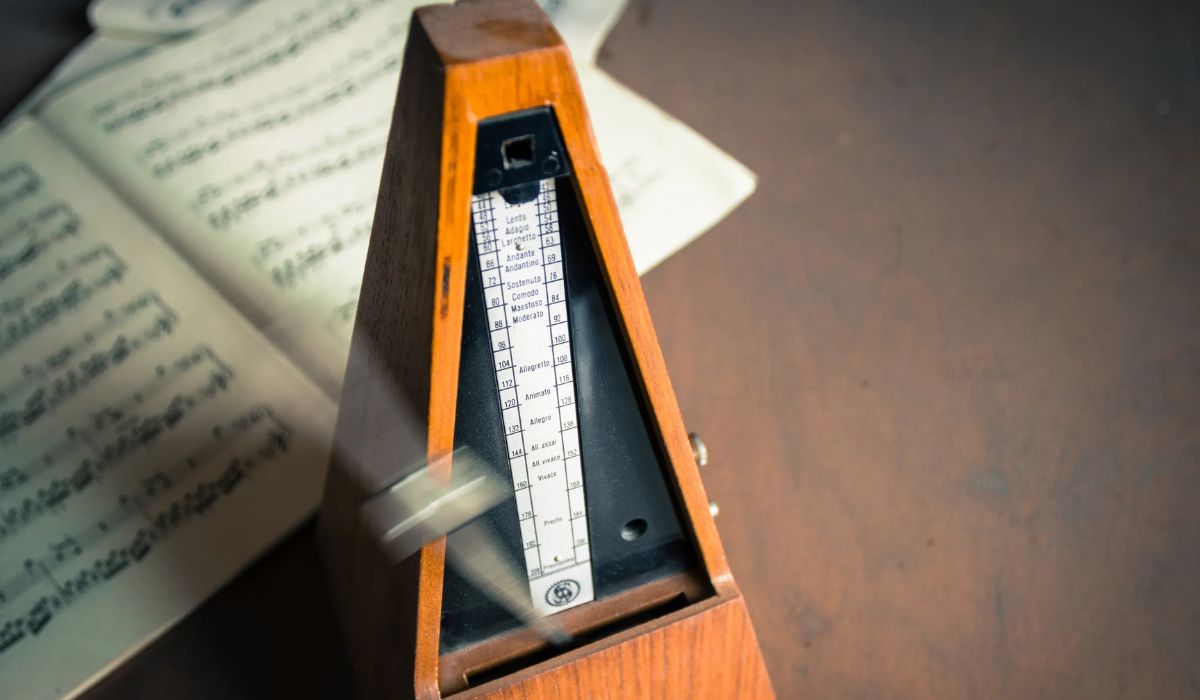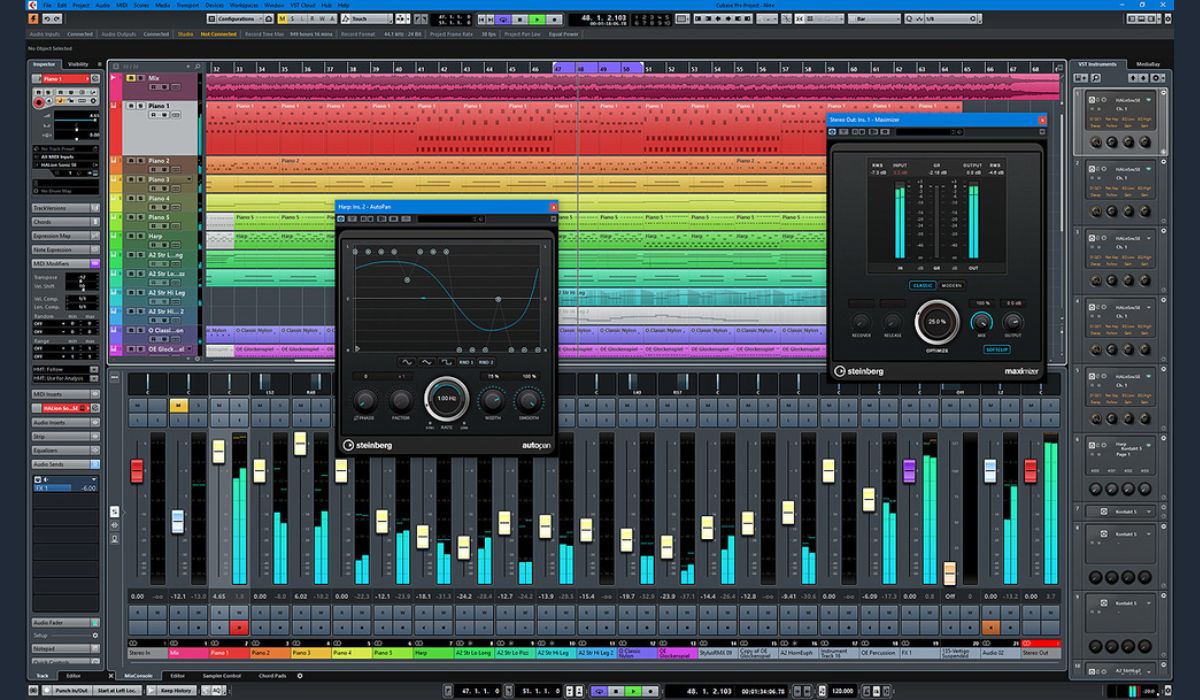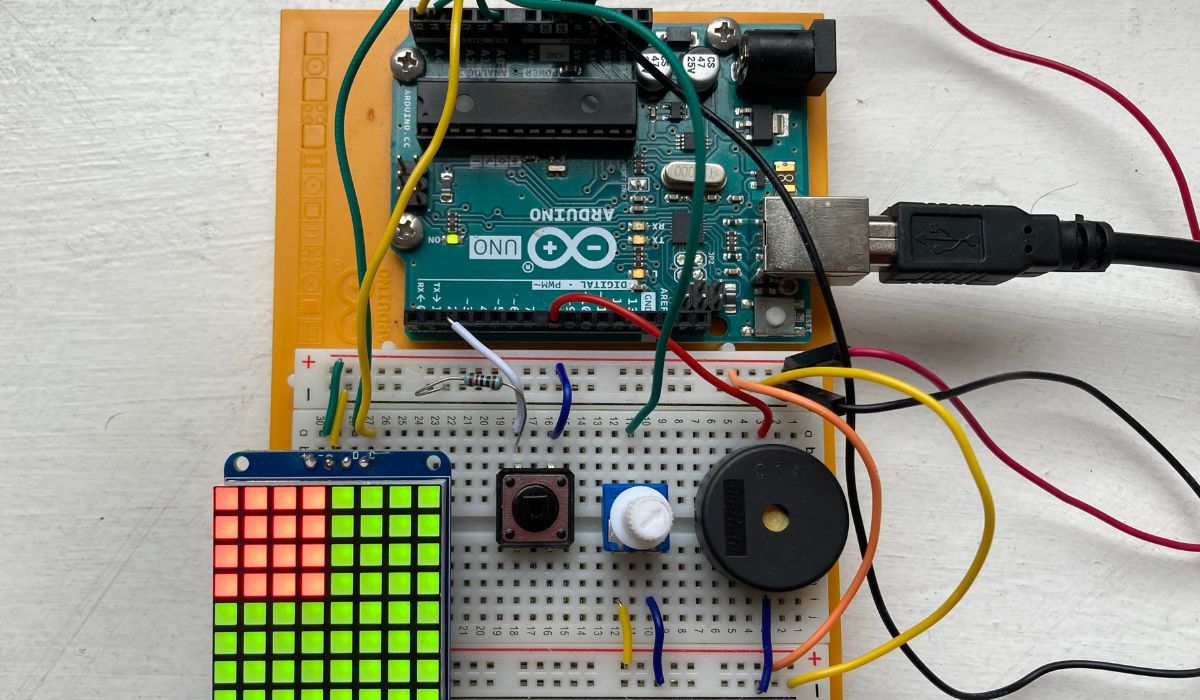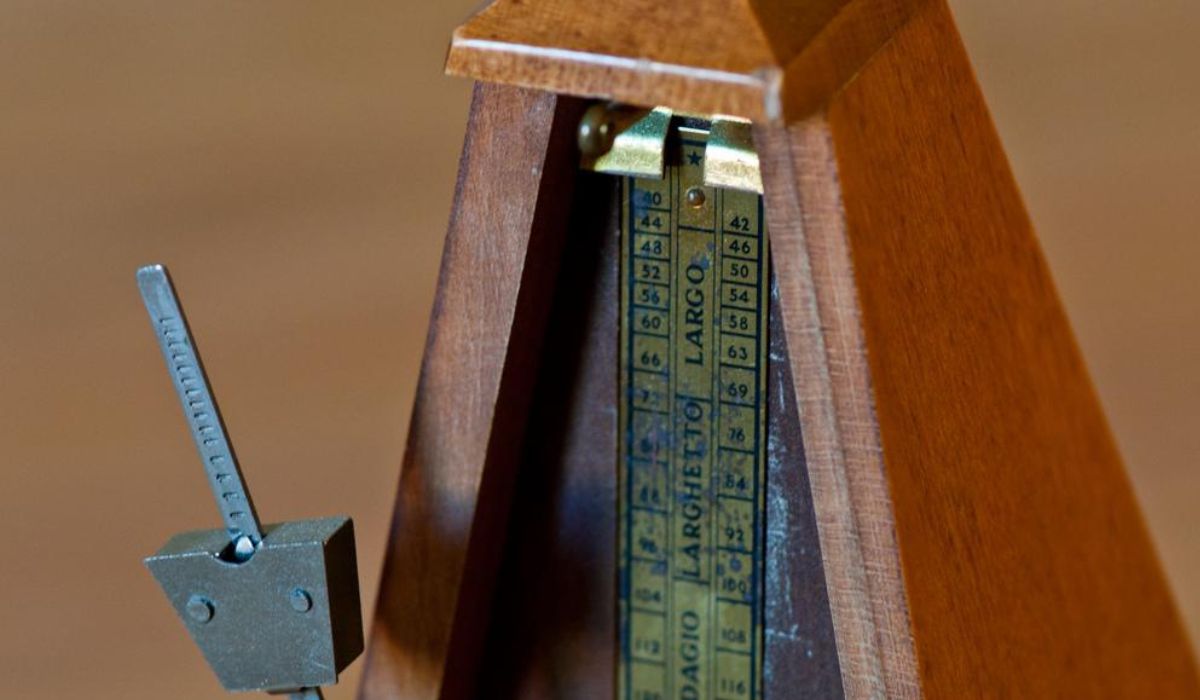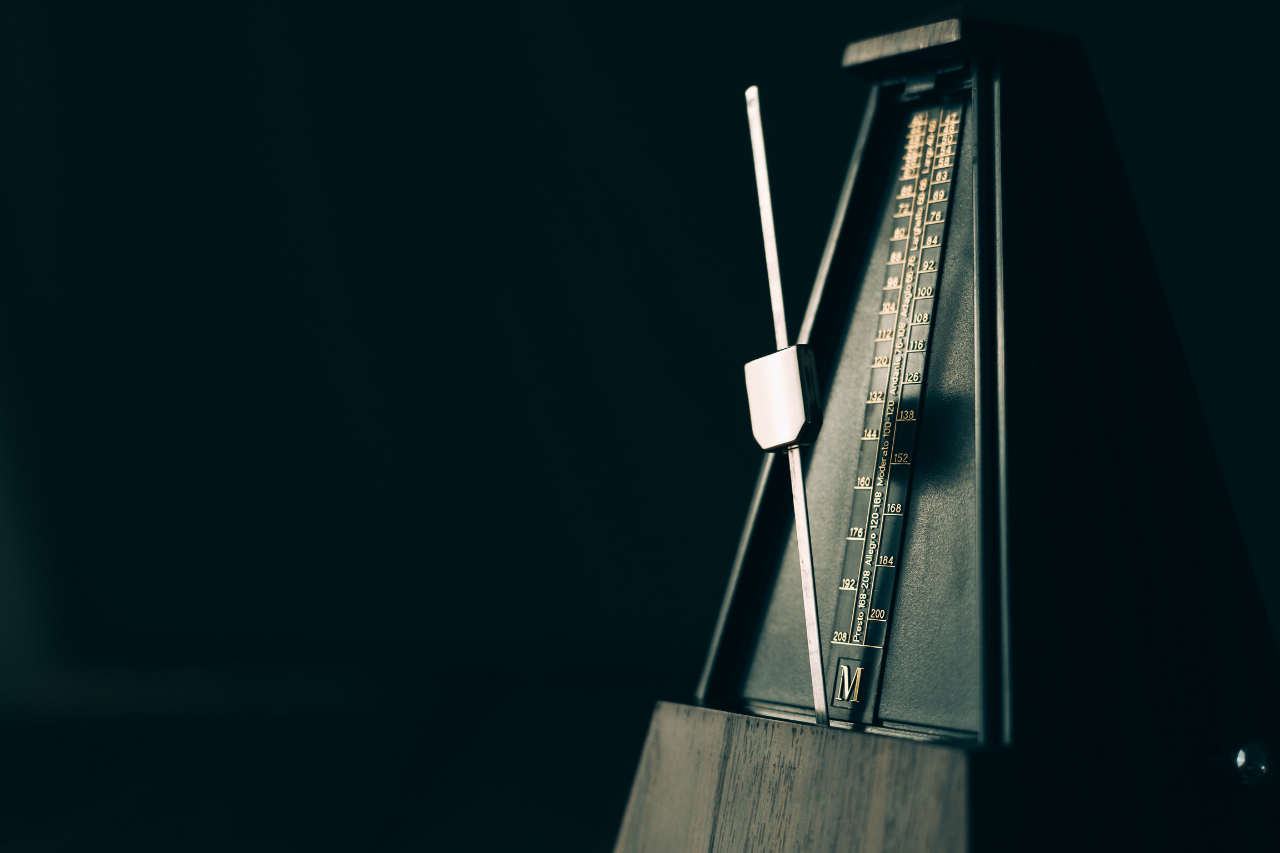Home>Production & Technology>Metronome>How To Play Ukulele With A Metronome


Metronome
How To Play Ukulele With A Metronome
Modified: January 22, 2024
Learn how to play ukulele with the help of a metronome. Improve your timing and rhythm with this essential practice tool.
(Many of the links in this article redirect to a specific reviewed product. Your purchase of these products through affiliate links helps to generate commission for AudioLover.com, at no extra cost. Learn more)
Table of Contents
- Introduction
- What is a Metronome?
- Benefits of Using a Metronome for Ukulele
- Getting Started with a Metronome
- Setting Up Your Metronome
- Choosing a Tempo
- Playing Basic Ukulele Chords with a Metronome
- Playing Melodies and Strumming Patterns with a Metronome
- Tips for Practicing Ukulele with a Metronome
- Common Mistakes to Avoid
- Conclusion
Introduction
Learning to play the ukulele is an exciting journey filled with beautiful melodies and chords. Whether you’re a beginner or an experienced player, sharpening your sense of timing and rhythm is essential for musical growth. And that’s where a metronome comes in. In this article, we’ll explore the benefits of using a metronome for ukulele playing and provide you with practical tips on how to incorporate this powerful tool into your practice routine.
A metronome is a device that produces regular, steady beats at a specific tempo. It acts as a musical timekeeper, helping musicians stay in sync and maintain a consistent pulse while playing. By practicing with a metronome, you can improve your timing accuracy, develop a strong internal sense of rhythm, and enhance your overall musicality. This is crucial for playing with other musicians or performing in a band, as it ensures that everyone stays in time and creates a cohesive sound.
Using a metronome for ukulele practice offers numerous benefits. Firstly, it helps you develop precision and control in your playing. By aligning your strumming or fingerpicking with the metronome’s beats, you’ll train your muscles to execute each note accurately, resulting in cleaner and more precise playing. This is particularly important when learning complex fingerpicking patterns or intricate chord progressions.
Additionally, practicing with a metronome improves your timing and rhythmicality. It strengthens your ability to maintain a steady tempo and play in sync with other musicians. This is especially valuable if you plan on performing solos, accompanying singers, or collaborating with other musicians. By honing your timing skills, you’ll be able to create dynamic and cohesive musical experiences.
Using a metronome can also enhance your musical creativity. Once you have a strong foundation in rhythm, you can experiment with different tempos, explore syncopated rhythms, and create unique strumming patterns. The metronome serves as a reliable reference point, allowing you to push the boundaries of your playing and unlock new musical possibilities.
In the following sections, we’ll delve into the practical aspects of using a metronome for ukulele practice. We’ll explore how to set up and choose the right tempo, as well as provide guidance on playing chords, melodies, and strumming patterns with a metronome. Additionally, we’ll share some valuable tips and common mistakes to avoid. So, let’s dive in and start making music with our trusty metronome by our side!
What is a Metronome?
A metronome is a musical tool that provides a consistent and precise beat or pulse to help musicians play in time. It is commonly used by musicians of all levels, from beginners to professionals, to improve their timing and rhythmicality. Traditionally, metronomes were mechanical devices that produced an audible click or ticking sound. However, with technological advancements, electronic and digital metronomes have become popular alternatives.
The main purpose of a metronome is to establish a steady tempo or rhythm for a piece of music. It allows musicians to play at a consistent speed, regardless of the complexity of the piece or the musician’s skill level. The tempo is usually measured in beats per minute (BPM), which indicates the number of beats or pulses per minute.
Metronomes come in various forms, from traditional mechanical ones with a swinging pendulum to digital ones with visual displays and programmable features. Some metronomes also have additional features such as different sounds and subdivisions, which can help musicians practice complex rhythms. Whether it’s a physical device or a digital app on your smartphone or computer, the purpose remains the same: to provide a reliable and consistent beat for practice.
When practicing with a metronome, musicians can set the tempo to match the desired speed of the piece they are playing. This allows them to develop a sense of timing and precision while keeping a steady rhythm. Beginners can start with slower tempos and gradually increase the speed as they become more comfortable and proficient. Advanced musicians can use the metronome to refine their timing and accuracy, ensuring that every note is played at the intended rhythm.
In addition to helping musicians play in time, metronomes can also be used to practice various rhythmical components of music, such as subdivisions and accents. By setting the metronome to a slower tempo and increasing the number of subdivisions per beat, musicians can work on intricate rhythms and improve their ability to play with precision and clarity.
In summary, a metronome is an invaluable tool for musicians looking to improve their timing, rhythmicality, and overall musicality. Whether you’re a ukulele player, guitarist, pianist, or any other musician, incorporating a metronome into your practice routine can greatly enhance your playing and make you a more confident and precise performer.
Benefits of Using a Metronome for Ukulele
Using a metronome during your ukulele practice sessions can have a multitude of benefits that contribute to your growth as a musician. Let’s explore some of the key advantages:
- Improved Timing and Rhythm: One of the primary benefits of using a metronome is that it helps you develop a strong sense of timing and rhythm. By practicing with a consistent beat, you’ll train your internal clock and learn to play in perfect sync with the music. This skill is crucial for playing in a band or ensemble, as it ensures that you stay in time with other musicians, creating a cohesive and harmonious performance.
- Enhanced Precision and Control: Playing the ukulele with precision and control is essential for creating a clean and articulate sound. A metronome helps you achieve this by providing a steady beat against which you can align your strums, chords, and melodies. By practicing with a metronome, you’ll develop muscle memory and improve your ability to execute each note accurately, leading to cleaner and more professional-sounding playing.
- Consistency in Tempo: Many songs have specific tempo requirements, and maintaining a consistent tempo is crucial for performing them effectively. Using a metronome helps you establish and maintain a steady tempo throughout a piece. This ensures that you don’t accidentally rush or slow down, providing a more enjoyable and cohesive musical experience for both yourself and your audience.
- Building Speed and Dexterity: If you’re interested in playing fast-paced ukulele pieces, a metronome is an invaluable tool for building speed and dexterity. By gradually increasing the tempo on the metronome, you can challenge yourself to play at faster speeds while maintaining accuracy. This gradual progression helps build muscle memory and train your fingers to navigate the fretboard effortlessly at high speeds.
- Developing Musicality: Playing the ukulele is not just about hitting the right notes; it’s also about conveying emotions and expressing yourself through music. By practicing with a metronome, you’ll develop a deeper understanding of the rhythmic elements in music. This will allow you to experiment with different strumming patterns, accents, and syncopations, ultimately enhancing your musicality and creative expression.
- Playing in Different Styles: The ukulele can be used to play various musical genres, each with its own unique rhythm and style. By practicing with a metronome, you’ll become more comfortable and proficient in playing different styles, such as reggae, blues, jazz, or folk. The metronome will keep you grounded and help you internalize the specific rhythmic nuances of each genre.
These are just a few of the many benefits of incorporating a metronome into your ukulele practice sessions. Remember, consistent and deliberate practice with a metronome will enable you to develop a solid foundation in rhythm and timing, allowing you to become a versatile and accomplished ukulele player.
Getting Started with a Metronome
If you’re new to using a metronome for your ukulele practice, getting started may seem a bit daunting at first. However, with a few simple steps and some practice, you’ll quickly integrate this valuable tool into your routine. Here’s a guide to help you get started:
- Acquire a Metronome: The first step is to obtain a metronome. You have several options: traditional mechanical metronomes, digital metronome apps on your smartphone or computer, or metronome features on music software. Choose a metronome that suits your preferences and budget, making sure it has the necessary features for your practicing needs.
- Familiarize Yourself with Basic Functions: Take some time to get familiar with the basic functions of your metronome. Learn how to set the tempo, adjust the volume, and select the time signature. Understanding these functions will allow you to customize the metronome settings according to the piece you’re practicing.
- Start with a Comfortable Tempo: When beginning with a metronome, it’s essential to select a tempo that feels comfortable for you. Start with a slower tempo and gradually increase it as you gain confidence and proficiency. Remember to focus on accuracy and precision rather than speed initially.
- Align with the Beat: As you begin playing with the metronome, listen carefully to the beat and make sure your strums, chord changes, and melodies align with it. This ensures that you’re playing in time and maintaining a steady rhythm. Concentrate on synchronizing your movements with the metronome’s beats.
- Count along: Counting along with the beats of the metronome can help internalize the rhythm and improve your sense of timing. Whether it’s counting beats, subdivisions, or bars, practicing counting while playing will reinforce your understanding of rhythm and help you stay on track.
- Gradually Increase the Difficulty: Once you’ve become comfortable playing with the metronome at a slower tempo, gradually increase the speed or introduce more complex rhythmic patterns. This gradual progression challenges you to improve your playing skills while maintaining a solid foundation in rhythm.
- Experiment and Have Fun: Don’t be afraid to experiment and have fun with the metronome. Use it as a tool to explore different strumming patterns, syncopations, and rhythmic variations. The metronome provides a reliable reference point, allowing you to push the boundaries of your ukulele playing and unlock new creative possibilities.
Remember, practice makes perfect, so incorporating the metronome into your daily routine is key. Just a few minutes of focused practice with a metronome each day can yield significant improvements in your timing, rhythm, and overall playing. As you practice more regularly, you’ll notice that playing without a metronome becomes easier, as you’ve trained your internal sense of rhythm and timing. So, embrace the metronome as your musical ally and let it guide you toward becoming a more confident and precise ukulele player.
Setting Up Your Metronome
Setting up your metronome correctly is crucial for effective practice sessions. Here are some key steps to ensure your metronome is properly configured:
- Choose the Right Metronome: Select a metronome that suits your needs and preferences. Consider whether you prefer a mechanical metronome or a digital one. Mechanical metronomes have a traditional aesthetic and produce an audible ticking sound. Digital metronomes, on the other hand, offer more features and flexibility, such as different sounds and programmable options. Choose one that best aligns with your practicing style and budget.
- Determine the Time Signature: The time signature of a piece determines the rhythmic structure and the number of beats in each measure. It is typically represented by two numbers, such as 4/4 or 3/4. Adjust your metronome’s time signature settings to match the time signature of the piece you’re practicing.
- Select the Desired Tempo: The tempo indicates the speed at which the beats occur. It is measured in beats per minute (BPM). Choose an appropriate tempo for the piece or exercise you’re working on. If you’re uncertain, start with a slower tempo and gradually increase it as you become more comfortable.
- Experiment with Sounds: Most digital metronomes offer a variety of sound options. Explore different sounds to find one that resonates with you and keeps you engaged during your practice sessions. Some metronomes even have the option to use different instruments or custom sounds, allowing you to personalize the experience to your liking.
- Set the Subdivision: Subdivisions are smaller divisions of each beat that help you internalize complex rhythms. If you’re practicing a piece with intricate rhythms, set your metronome to play subdivisions. For example, if the main beat is a quarter note, you can set the metronome to also play eighth notes or sixteenth notes, depending on the complexity of the piece.
- Choose the Volume: Ensure that the volume of your metronome is audible but not overpowering. Find a balance that allows you to clearly hear the beats without drowning out your ukulele playing. Adjust the volume according to your environment and personal preference.
- Sync with External Devices: If you’re using a digital metronome app or software, you can often sync it with other devices or software you may be using for accompanying tracks or recordings. This allows you to practice along with the metronome while incorporating other musical elements.
- Place the Metronome in a Visible Spot: Position your metronome where you can easily see it while playing. This will help you stay focused and aligned with the beats. Placing it at eye level or on a music stand near your ukulele is often a suitable option.
These steps will help you set up your metronome effectively for your ukulele practice sessions. Adjusting the settings according to the piece you’re practicing and your personal preferences will ensure that the metronome becomes a helpful tool in your musical journey. Remember, the goal is to develop a steady and consistent sense of timing and rhythm, so use the metronome as a guide to refine your skills and elevate your ukulele playing.
Choosing a Tempo
Choosing the right tempo is essential when using a metronome for your ukulele practice. The tempo sets the speed at which the beats occur and determines the overall feel and energy of the music. Here are some guidelines to help you choose an appropriate tempo:
- Consider the Genre: Different musical genres often have specific tempo ranges associated with them. For example, reggae tends to have a relaxed and laid-back feel with tempos around 70-90 BPM, while fast-paced bluegrass may have tempos ranging from 180-240 BPM. Consider the genre of the piece you’re practicing and aim for a tempo that aligns with its characteristic speed.
- Listen to Recordings: Listening to recordings of songs or pieces you’re working on is a great way to get a sense of the appropriate tempo. This will give you an idea of how the music should sound and help you choose a tempo that matches the original recording or the desired interpretation of the piece.
- Start Slow: If you’re unsure about the tempo, it’s always better to start with a slower speed and gradually increase it. Starting slow allows you to focus on accuracy and precision, ensuring that you play each note correctly. As you become more comfortable, you can gradually push the tempo to a faster pace.
- Consider the Complexity: The complexity of the piece or exercise you’re practicing should also influence your tempo choice. More challenging and intricate passages may require a slower tempo to allow for clean execution. As you become more proficient, you can gradually increase the tempo without sacrificing accuracy.
- Match the Feel of the Music: The tempo you choose should match the desired feel and energy of the music as well. If you’re playing a joyful and upbeat song, a faster tempo may be suitable. On the other hand, if you’re working on a ballad or a slower, introspective piece, a slower tempo will help convey the intended emotions.
- Experiment and Personalize: Don’t be afraid to experiment with different tempos and adjust them to your own preferences. The metronome is a flexible tool that allows you to tailor the tempo to your specific needs. As you become more comfortable with a piece, you may find that slightly altering the tempo enhances your interpretation and musical expression.
Remember that the tempo you choose should ultimately feel comfortable to you as a player. It should allow you to maintain control and play with precision. The metronome serves as a guide, helping you develop a solid sense of timing and rhythm, but it’s important to find a tempo that complements your playing style and musical intent.
By considering the genre, complexity, and desired emotions of the music, as well as taking into account personal preferences and comfort, you can confidently choose a tempo that enhances your ukulele playing. So enjoy the process of finding the perfect tempo and let the metronome be your trusty companion in your musical journey!
Playing Basic Ukulele Chords with a Metronome
Practicing basic ukulele chords with a metronome is an effective way to improve your chord transitions, timing, and overall proficiency on the instrument. Here’s how you can incorporate a metronome into your chord practice:
- Select a Chord Progression: Choose a chord progression that you want to work on. Start with simple progressions, such as C-Am-F-G or G-Em-C-D. These progressions will allow you to focus on the fundamentals while integrating the metronome.
- Set the Tempo: Determine the tempo at which you want to practice. If you’re a beginner, start with a slower tempo, around 60-80 BPM. As you become more comfortable, you can gradually increase the speed.
- Strum on Each Beat: Strum the chord on each beat of the metronome. Start by strumming once per beat (downstroke or upstroke) in a consistent and even manner. Focus on synchronizing your strums with the metronome’s beats, ensuring that each strum aligns perfectly with the rhythm.
- Alternate Strumming Patterns: Once you feel comfortable strumming on each beat, experiment with different strumming patterns. You can try down-up strumming (using both downstrokes and upstrokes), or incorporate more complex patterns like syncopated strumming or fingerpicking. The metronome will help you stay in time as you explore various strumming techniques.
- Work on Smooth Transitions: Pay close attention to your chord transitions. Use the metronome as a guide to make smooth and seamless changes between chords. Focus on keeping your fingers relaxed and minimizing any unnecessary movements during the transitions. The metronome’s steady beat will help you maintain a consistent rhythm as you switch between chords.
- Gradually Increase the Tempo: As you become more comfortable with the chord progression and transitions, gradually increase the tempo on the metronome. Challenge yourself to play at faster speeds while maintaining accuracy and control. This will help build your muscle memory and train your fingers to transition quickly and efficiently between chords.
- Be Consistent and Patient: Consistency is key when practicing with a metronome. Make it a habit to incorporate the metronome into your daily practice routine. Be patient with yourself as you progress. It’s normal to make mistakes or struggle with certain transitions in the beginning. The metronome will help you develop a sense of discipline and precision over time.
By practicing basic ukulele chords with a metronome, you’ll develop a solid foundation in rhythm, timing, and chord transitions. Remember to start at a comfortable tempo and gradually increase the speed as you gain confidence. The metronome serves as your reliable timekeeper, ensuring that you stay in sync with the beat and develop a strong sense of timing. So grab your ukulele, set your metronome, and strum your way to chord mastery!
Playing Melodies and Strumming Patterns with a Metronome
Using a metronome to practice melodies and strumming patterns on the ukulele can greatly enhance your musicality and timing. Whether you’re playing a melody or accompanying yourself with rhythmic strumming, incorporating a metronome can help improve your precision and sense of rhythm. Here’s how to integrate a metronome into your practice sessions:
- Select a Melody or Strumming Pattern: Choose a melody or strumming pattern that you want to work on. It can be a simple melody from a song or a strumming pattern that you find challenging. Starting with a familiar or manageable piece will help you focus on coordination with the metronome.
- Set the Tempo: Set the metronome to an appropriate tempo for your chosen melody or strumming pattern. If you’re unsure where to start, begin with a moderate tempo, around 70-80 BPM. You can always adjust it according to your comfort and skill level.
- Practice Playing Along: Start by playing your melody or strumming pattern along with the metronome. Pay close attention to synchronizing your timing with the metronome’s beats. Listen carefully and ensure that your notes or strums align perfectly with the metronome’s pulse.
- Focus on Accuracy: It’s essential to play each note or strum with accuracy and clarity. The metronome will help you develop a consistent rhythm and ensure that your playing remains in time. Concentrate on hitting the right notes or executing the strumming pattern correctly, paying attention to details like timing, dynamics, and articulation.
- Experiment with Different Tempos: Once you feel comfortable playing along with the metronome, experiment with varying tempos. Challenge yourself by gradually increasing the tempo to test your ability to maintain accuracy and control at faster speeds. Also, try lowering the tempo to a slower pace to practice more complex melodies or strumming patterns with precise articulation.
- Add Variations: As you become more proficient, try adding variations to the melody or strumming pattern. This could include ornaments, improvisations, or rhythmic embellishments. The metronome will provide a solid foundation for your variations, allowing you to maintain rhythmic integrity while exploring your own creative ideas.
- Record and Analyze: Record yourself playing along with the metronome and listen back to assess your performance. Pay attention to any areas where your timing may be off or any sections that need improvement. Use this feedback to refine your playing and further strengthen your sense of timing and rhythm.
Using a metronome while practicing melodies and strumming patterns on the ukulele will help you develop precision, timing, and consistency in your playing. It can also serve as a guide for exploring creative variations and adding expression to your music. Embrace the metronome as your musical companion, and enjoy the process of honing your skills and immersing yourself in the rhythm of the ukulele.
Tips for Practicing Ukulele with a Metronome
Practicing the ukulele with a metronome is a valuable tool for improving your timing, rhythm, and overall musicality. Here are some helpful tips to enhance your practice sessions:
- Start Slow and Gradually Increase Tempo: Begin practicing with a metronome at a comfortable tempo. Focus on accuracy and precision before increasing the speed. Gradually increase the tempo as you become more comfortable to challenge yourself and improve your playing skills.
- Use Subdivisions: Utilize subdivisions on the metronome to practice playing in different rhythmic patterns. Start with simpler subdivisions, such as eighth notes, and progress to more complex ones, like sixteenth notes, as your skills develop. This helps to reinforce your timing and rhythm precision.
- Focus on Transitions: Pay attention to your chord transitions or fingerpicking changes when practicing with a metronome. Use the metronome’s beat as a guide to ensure smooth and fluid transitions between chords or notes. This will improve your overall playing technique and make your performance more polished.
- Experiment with Different Styles and Genres: The metronome allows you to practice different styles and genres of music with precision. Explore various strumming patterns, fingerstyle techniques, and rhythmic variations using the metronome as your rhythmic foundation. It’s a great way to expand your musical horizons and develop versatility on the ukulele.
- Count Out Loud: As you practice with the metronome, count out loud along with the beats. This helps reinforce your sense of rhythm and internalize the timing. Counting aloud also keeps you focused and engaged with the metronome’s rhythm throughout your practice session.
- Solo vs. Accompaniment: Different pieces of music may require different approaches. When practicing solos, use the metronome to improve your timing and phrasing. For accompaniment, focus on strumming or fingerpicking in sync with the metronome to ensure tight rhythm and synchronization with other musicians.
- Record and Evaluate: Take advantage of technology to record your practice sessions with the metronome. Listen to your recordings to assess your timing and areas that need improvement. Self-evaluation is an excellent way to track your progress and identify areas for further development.
- Be Patient and Consistent: Developing a sense of timing and rhythm takes time and consistent practice. Be patient with yourself and embrace the learning process. Dedicate regular practice time to work with the metronome, even if it’s just a few minutes each day. Consistency is key to improving your skills over time.
By incorporating these tips into your practice routine, you’ll effectively harness the power of the metronome and optimize your ukulele playing. With patience, persistence, and a rhythmic foundation provided by the metronome, you’ll enhance your skills and become a more confident and proficient ukulele player.
Common Mistakes to Avoid
When practicing with a metronome, it’s important to be aware of common mistakes that can hinder your progress. By avoiding these pitfalls, you can make the most out of your time with the metronome and maximize your growth as a ukulele player. Here are some common mistakes to watch out for:
- Ignoring rhythm dynamics: It’s easy to get caught up in playing the right notes or strumming patterns without paying attention to the dynamics of the rhythm. Remember to vary your dynamics and accents to create a more expressive and engaging performance.
- Relying solely on the metronome: While the metronome is a valuable tool for developing rhythm and timing, it’s essential to also practice without it. This helps you develop a personal sense of rhythm and internalize the timing rather than depending solely on the metronome’s guidance.
- Playing mechanically: It’s crucial to avoid playing mechanically, where you’re solely focused on keeping up with the metronome’s beats. Instead, strive for a musical and nuanced performance by incorporating dynamics, phrasing, and expression into your playing.
- Neglecting subdivisions: Subdivisions are essential for mastering complex rhythms. Neglecting to practice subdivisions can result in uneven and inaccurate playing. Make sure to incorporate subdivisions into your practice routine to improve your sense of rhythm and precision.
- Ignoring mistakes: When practicing with a metronome, it’s important to address mistakes rather than ignoring them. Use the metronome to identify areas where you struggle and focus on practicing those specific sections to improve your accuracy.
- Getting fixated on speed: While it’s exciting to play at faster tempos, don’t get fixated on speed at the expense of accuracy and control. Focus on playing each note or strum with precision, gradually increasing the tempo only when you feel comfortable and in control.
- Being too rigid: Although the metronome provides a steady beat, it’s important to maintain a sense of flexibility. Music should never feel robotic or stiff. Allow for some slight variations in timing and feel to create a more organic and expressive interpretation.
- Neglecting other aspects of playing: While the metronome helps improve timing and rhythm, don’t forget to work on other aspects of your ukulele playing, such as technique, tone production, and musicality. Balance your practice sessions to address all areas of your musical development.
By avoiding these common mistakes, you can ensure that your practice sessions with the metronome are productive and beneficial. Remember to focus on musicality, dynamics, and precision while using the metronome as a guide to refine your timing and rhythm. With consistent practice, you’ll be able to integrate these skills and become a well-rounded and accomplished ukulele player.
Conclusion
Incorporating a metronome into your ukulele practice can have a transformative impact on your playing. It serves as a reliable guide, helping you develop a strong sense of timing, rhythm, and precision. By using the metronome effectively, you can enhance your musicality and elevate your overall playing skills.
Throughout this article, we’ve explored the various benefits of using a metronome for ukulele practice. It improves your timing accuracy, develops your sense of rhythm, enhances your precision and control, and expands your creative possibilities. Whether you’re a beginner or an advanced player, the metronome offers valuable guidance and support on your musical journey.
We discussed how to set up your metronome, choose the right tempo, and practice basic chords, melodies, and strumming patterns. We also provided tips to help you get the most out of your practice sessions and highlighted common mistakes to avoid.
Remember, practice and consistency are key when using a metronome. Gradually increase the tempo, challenge yourself with diverse styles and genres, and don’t forget to focus on technique, tone production, and musicality alongside rhythm and timing.
By incorporating a metronome into your daily practice routine and implementing the tips and strategies outlined in this article, you’ll witness significant improvements in your ukulele playing. Embrace the metronome as a valuable tool and enjoy the journey of honing your skills, refining your sense of rhythm, and becoming a more confident and expressive musician.

